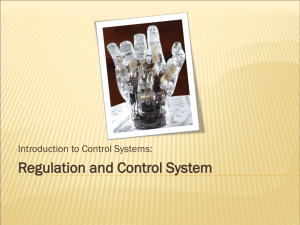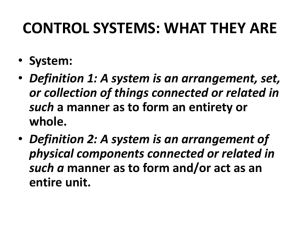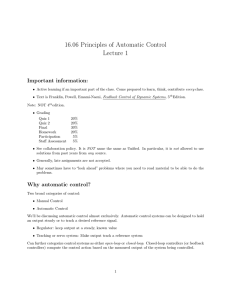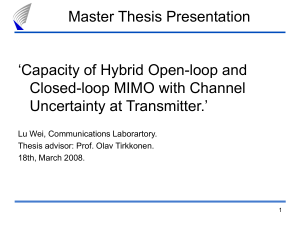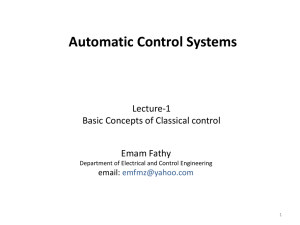Automatic Control Principles: Course Intro & System Design
advertisement
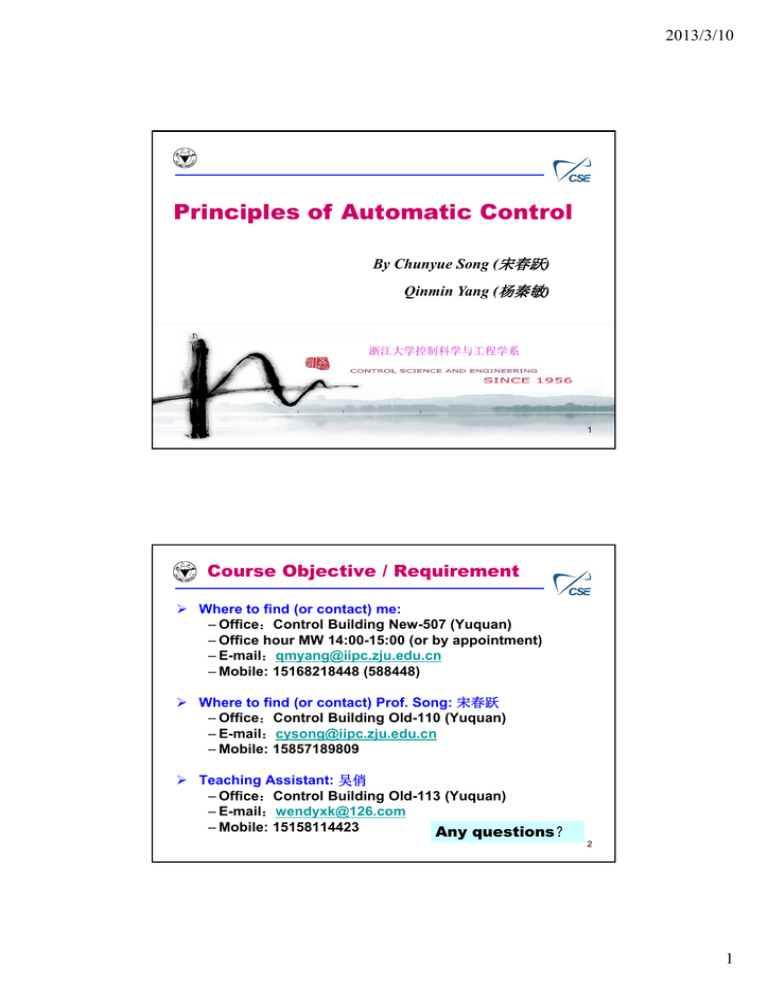
2013/3/10 Principles of Automatic Control By Chunyue Song (宋春跃) Qinmin Yang (杨秦敏) 浙江大学控制科学与工程学系 1 Course Objective / Requirement Where to find (or contact) me: – Office:Control Building New-507 (Yuquan) – Office hour MW 14:00-15:00 (or by appointment) – E-mail:qmyang@iipc.zju.edu.cn – Mobile: 15168218448 (588448) Where to find (or contact) Prof. Song: 宋春跃 – Office:Control Building Old-110 (Yuquan) – E-mail:cysong@iipc.zju.edu.cn – Mobile: 15857189809 Teaching Assistant: 吴俏 – Office:Control Building Old-113 (Yuquan) – E-mail:wendyxk@126.com – Mobile: 15158114423 Any questions? 2 1 2013/3/10 Course Objective / Requirement Objectives: cybernetics – To introduce the fundamental principles of control theory – To develop the basic understanding of control systems – To learn how to analyze and how to design automatic control systems – Bonus: English? – More to say ... Requirements: – Preparation, attendance and review – Let me know if you must miss a class – Finish homework assignments on schedule – Penalty for late delivery (80% full credit) Grading policy: – Attendance, homework, quiz: 30% – Midterm: 10-20% (April 17th) – Final Exam: 50-60% – Final Project (PAC II) 3 Course Objective / Requirement Where to find course materials – Courses center: http://www.cse.zju.edu.cn/eclass/ 控制系主页-本科教学平台-本科网络课程平台 核心课程:自动控制原理 I – 我的主页:http://mypage.zju.edu.cn/en/qmyang Prerequisites – Calculus, Ordinary Differential Equation, Linear Algebra, Complex Function Theory, Circuit 4 2 2013/3/10 Course Objective / Requirement Textbooks & Refs: – English: 1. John J.D’Azzo, Constantine H.Houpis, 2001, 2006 Linear Control System Analysis and Design (Fourth or Fifth Edition) 2. Richard C. Dorf, Robert H. Bishop, 2008 Modern Control Systems(Eleventh Edition) 3. Karl Johan Astrom & Richard M. Murray, 2008 Feedback Systems---An Introduction for Scientists and Engineers 5 Course Objective / Requirement Textbooks & Refs: – Chinese: 1. 孙优贤、王慧主编,《自动控制原理》,化学工业出版社,2012 2. 胡寿松主编. 《自动控制原理》(第四版);2001,科学出版社 3. 周春晖主编. 《化工过程控制原理》(第二版);1998,化工出版社 4. 《自动控制系统》 (第八版) ;汪小帆,李翔译,2004,高等教育出版社 5. 《现代控制系统》(第八版),谢红卫等译,2001,2006,高教出版社 6. 《动态系统的反馈控制》 (第四版) ;朱齐丹等译, 电子工业 出版社 6 3 2013/3/10 CHAPTER 1 Introduction to Control Systems 控制科学与工程学系 Outline Course Outline Introduction to Control Systems Definitions Historical Background Mathematical Background Engineering Control Problem Basic Form of Block Diagram 8 4 2013/3/10 Introduction to Control Systems "The philosophers have only interpreted the world, in various ways; the point is, however, to change it.“ - in ‘Theses on Feuerbach’, Karl Marx 1845 The capability of effective control is the unique characteristic distinguishing human beings and animals. 9 Introduction: What Can Control Achieve? Make a system behave as desired Keep output constant or varying as wanted (most processes, aircraft) Stabilize unstable system (inverted pendulum) Reduce disturbance effects (quadrotor ) New freedom and tools for designers Y(s)=G(s)X(s) X(s) G(s) Block diagram 10 5 2013/3/10 Key Words Required knowledge – Model Mathematic, diagram, response, rule, etc… – Control theory Linear, nonlinear … – System theory Optimal design, robustness … Assumptions to make 11 Key Words System (Automatic) Control System Input, Output Open-loop Control system Closed-loop Control system (Negative Feedback-control systems) Dynamic, Static 12 6 2013/3/10 Basic Concepts – Systems System – A collection of components which are coordinated together to perform a specific function. Static System – I/O relationship is not time dependent – the output is determined by the current input only Dynamic System – A system with a memory. – For example, the input value at time t will influence the output at future instant. A system interact with their environment through a controlled boundary. 13 Basic Concepts – Interaction The interaction is defined in terms of variables. i. System input ii. System output iii. Environmental disturbances iv. State variables (internal variables) and Subsystems 14 7 2013/3/10 Basic Concepts – System Variables The system’s boundary depends upon the defined objective function of the system. The system’s function is expressed in terms of measured output variables (CV). The system’s operation is manipulated through control input variables (MV). The system’s operation is also affected in an uncontrolled manner through disturbance input variables (DV). – measured variable = CV = controlled variable 被控变量 – control variable = MV = manipulated variable 控制变量 15 Introduction to Control Systems Control: is the process of causing a system variable (e.g, temperature, position….) to conform to a desired value or trajectory, called reference value or trajectory, by means of some sort of efforts. 自动控制系统:在无人直接参与下可使生产过程或其 他过程按期望规律或预定程序进行的控制系统。 A control system consisting of interconnected components is designed to achieve a desired purpose. 16 8 2013/3/10 Manual vs. Automatic Control Example: driving a car implies controlling the vehicle to follow the desired path and arrive safely at a planned destination. If you drive the car yourself, you are performing a manual control of the car. If you design a machine to do it then you build an automatic control system. 17 Closed-Loop Control: -- Ex. A manual control system Objective: To control direction and speed of car Outputs: Actual direction and speed of car Control inputs: throttle pedal, brake, steering wheel Disturbances: Road surface and grade, wind, obstacles Possible subsystems: The car in mechanics, the engine system, the power steering system, the braking system, suspension system, ... 18 9 2013/3/10 Closed-Loop Control: -- Ex. A manual control system (a) Automobile steering control system. 视觉与触觉 (b) The driver uses the difference between the actual and the desired direction of travel to generate a controlled adjustment of the steering wheel. (c) Typical directionof-travel response. Adaptive Cruise Control----ACC 19 Unmanned Ground Vehicles – A teleoperated UGV is a vehicle that is controlled by a human operator at a remote location via a communications link. – An autonomous UGV is essentially an autonomous robot but is specifically a vehicle that operates on the surface of the ground. 20 10 2013/3/10 Open Loop Control: Ex. Microwave Input: Set time Output: Temperature If the temperature of the stuff to be warmed is not satisfactory, it cannot automatically alter the time. Timer 21 Open Loop Control: Ex. DC shunt motor (See P1-2, Fig. 1.1(b)直流并励电动机) Input: armature voltage (电枢电压) Output: speed of the shaft(轴) If a variation of the speed from the desired value appears, due to a change of mechanical load on the shaft, it is no way to change the value of input quantity automatically (e.g. electric fan). dynamic part 并激磁场 22 11 2013/3/10 Open-Loop System: Functional block diagram (See P2, Fig. 1.1(c)) Reference Input Reference selector Control Dynamic Output unit Input Figure 1.1 (c) Functional block diagram of a open-loop control system Temperature time Microwave voltage motor Timer Speed of the motor Desired output Setpoint/Reference Actuating device Temperature speed Process/Plant output The actual output has no effect upon the control input is called open-loop control system. 23 From Open-loop to Closed-Loop Control System (See P3, Fig. 1.2) Reference Input Command Input Reference selector + error - Feedback signal Actuating signal Forward elements System dynamics Output Feedback element Figure 1.2 Functional block diagram of a closed-loop control system • The closed-loop control system implies that the action results from the comparison between the output and input quantities in order to maintain the output at the desired value. • The output is controlled in order to achieve the desired value. 24 12 2013/3/10 Colsed-Loop Control: Ex.-- Household Furnace (See P4, Fig. 1.3)(家用取暖炉) Desired room temperature setting Actual room temperature Thermostat Hot-air vents Furnace Relay Fig. 1.3 Home heating control system bimetallic strip: difference in thermal expansion in the two metals leads to a much larger sideways displacement of the strip bimetallic coil If temperature inside the house is below (or above) the desired value, furnace turns on (turns off) until the temperature inside the house is slightly higher (lower) than the desired temperature. 25 Colsed-Loop Control: Ex.-- Household Furnace (See P3-4, Fig. 1.3)(家用取暖炉) Error signal Desired temp. Relay switch signal gain + heat furnace temp. house temperature sensor controller dynamic part 26 13 2013/3/10 Closed-Loop Control System: Ex.-- A manual control system Dynamic h Objective: To maintain the level in the tank a desired value If h<H, close valve; If h>H, open valve; Controlled Variable fluid Level Height H If h=H, maintain unchanged 27 Closed-Loop Control System: Ex.-- A manual control system Actuating Desired level. signal + (Error) control rules valve signal fluid valve dynamic level tank - Man’s brain level sensor: man’s eyes The system components 28 14 2013/3/10 Closed-Loop Control: Ex. -- Automatic control system FT FC Feedforward control Set point 给定值H Measurement Device Actual Value h HC HT 测量值 Control Variable 控制量u Actuating Signal Feedback control Actuator 带控制点的工艺流程图 29 Open-Loop/Closed-Loop Systems A control system is an interconnection of components. Each component is represented by a block in a diagram. Open Loop Desired output Control signal Controller Actuator Plant Plant output Closed-Loop Actuating Desired output signal Controller + Control signal Actuator Plant Plant output (Error) Sensor 30 15 2013/3/10 Colsed-Loop Control: Ex. --Elevator (See P4, Fig. 1.4 Automatic elevator) Chicago Sears Tower (more than 2400 steps, 103 floors and 443m high) • The express elevator in the Sears Tower is designed so that it ascends or descends in 55 sec., with maximum passenger comfort. 31 Definitions (See P6-7) System – An interconnection of elements and devices for a desired purpose. Control System – An interconnection of components forming a system configuration that will provide a desired response. Forward element (process; system dynamics) –The unit that reacts to an actuating signal to produce a desired output, i.e. the device, plant, or system under control. The input and output relationship represents the cause-and-effect relationship of the process. input output process Process to be controlled 32 16 2013/3/10 Definitions (See P6-7) Command input (desired output) – The motivating input signal to the system, which is independent of the output of the system.. Reference selector (reference input element) – The unit that establishes the value of the reference input (in terms of the desired output). Reference input – Produced by the reference selector, it is the actual signal input to the control system. Disturbance input – The signal to the system that has an unwanted effect on the system output. Output (controlled variable) – The quantity that must be maintained at a prescribed value, i.e, it must follow the command input without responding to disturbance inputs. 33 Definitions (See P6-7) Actuating signal (error signal) – It is the input to the control unit that causes the output to have the desired value. Usually, it is the difference between the reference input and the feedback signal. Control variable (manipulated variable) – The signal that is the output of the control unit, and as an input act directly on the process (system dynamic). The device that performs the action called actuating device. Actuating signal Control unit Control variable 34 17 2013/3/10 Definitions (See P6-7) Open-Loop Control Systems utilize a controller or control actuator to obtain the desired response. Disturbance input Feedback Element-The unit that provides the means for feeding back the output quantity. Closed-Loop Control Systems utilizes feedback to compare the actual output to the desired output response. SISO (single-input single output) Control System MIMO (multi-input multi-output) Multivariable Control System 35 Examples of Modern Control Systems 36 18 2013/3/10 Definitions (See P6-7) 干扰输入 前馈控 制器 给定值 输入 比较器 反馈控制器 过程 反馈通道 被控对象 输出 传感器 • Feedback Control and Feedforward Control - hybrid control 37 Examples of Modern Control Systems 38 19 2013/3/10 Examples of Modern Control Systems 39 Categorizing(不同分类) • Open-loop and Closed-loop control System • Feedback Control and Feedforward Control and Feedback-Feedforward Control • SISO Control System and MIMO Control System • Set-point Control System and Servo Control System (定值控制系统) (随动或称伺服控制系统) • Analog (continuous) Control System and Sampleddata (discrete) Control System 40 20 2013/3/10 Outline Course Outline Introduction to Control Systems Definitions Historical Background Mathematical Background Engineering Control Problem Basic Form of Block Diagram 41 Historical Background http://www.asc-cybernetics.org/foundations/timeline.htm First automatic feedback system invented in modern Europe (Holland) by Cornelis Drebbel (1572-1633) for temperature regulation of a furnace used to heat an incubator (培养的器具, 孵化小鸡的培育器) Intake of heat from the valve above Temperature sensor – alcohol & mercury & stick Principle – thermal expansion and contraction of alcohol 42 21 2013/3/10 Historical Background First automatic feedback controller used in an industrial process invented by James Watt in 1769 – the flyball governor – used to mantain the rotating speed of a shaft in a steam engine J.C.Maxwell (1868) formulated the first mathematical study of the stability of feedback control applied to a governor. Watt’s Flyball Governor (18th century) 飞球式(离心式)调速器 43 Historical Background The first historical feedback system, claimed by Russia, is the water-level float regulator said to have been invented by I. Polzunov in 1765. The float detects the water level and controls the valve that covers the water inlet in the boiler. 44 22 2013/3/10 Historical Background E.J.Routh determined a criteria for stability analysis in 1877 Lyapunov (1893) studied stability of motion (ODEs) The Wright Brothers achieved controlled flight (1903) Sperry (1910) worked on gyroscopes(陀螺仪) and autopilots Black proposed feedback electronic amplifier in 1927(AT&T, Bell) Nyquist derived a frequency domain stability criterion in 1932 45 Historical Background Bode developed frequency response methods in 1938 Ziegler-Nichols developed a method for PID tuning and Wiener develops optimal filter design in 1942 Evans developed the Root Locus in 1948 Pontryagin formulated the Maximum Principle in 1956 Bellman developed Dynamic Programming in 1957 Kalman formulated Optimal Estimation in 1960 Modern control Milestone Hoff invented the Microprocessor in 1969, then digital control is used extensively State variable methods and optimal control were further developed in 1970-1980 Robust and Nonlinear Control developed in 1980-1990 Multivariable Predictive Control developed and employed in process industry in 1980 46 23 2013/3/10 Historical Background Switched control, hybrid control, and control using convex optimization methods is developed in 1990-2000 Feedback control is widely used in automobiles and reliable, robust systems are heavily demanded in manufacturing starting in 1994 First ever autonomous rover vehicle, known as Sojourner explores successfully the Martian surface in 1997. Second lands successfully in January 3 2004. Control abstractions and control of piecewise-affine systems are developed starting in 1998-1999 and are still research topics as well as hybrid control 47 Cybernetics “自动控制理论” VS “控制论” The term cybernetics stems from the Greek κυβερνήτης (kybernētēs, steersman, governor, pilot, or rudder — the same root as government) The essential goal of cybernetics is to understand and define the functions and processes of systems that have goals and that participate in circular, causal chains that move from action to sensing to comparison with desired goal, and again to action. 48 24 2013/3/10 Cybernetics Some descriptions: “a science concerned with the study of systems of any nature which are capable of receiving, storing, and processing information so as to use it for control” - A.N. Kolmogorov 苏联最伟大的数学家之一 “the science of control and communication in the animal and the machine”-Norbert Wiener, 应用数学家、控制专家 《控制论-关于在动物 或机器中控制或通讯的科学》,1948 维纳抓住了一切通信和控制系统的共同特点, 即它们都包含着一个信息传输和信息处理的过 程:双向信息传输、调整、适应、随机。。。 49 Cybernetics “控制论”是一门“横断科学” 控制论的研究对象不是物质的特定结构或运动的特定形态,而是 普遍的结构和行为方式 关键概念:目的性、负反馈、稳定性 关键概念:控制、通讯、反馈、信息、适应、复杂性、网络、自 组织、自主性 “控制就是通讯”(维纳) 生命体和机器的统一 人机关系(服务、合作、竞争) 控制论的影响:控制理论、计算机科学、运筹学、优化理论、信 息理论、人工智能、神经网络、认知科学、动力系统。。。 50 25 2013/3/10 IFAC (International Federation of Automatic Control) http://www.ifac.org/; http://www.ifac-control.org/ Education Organization Application Journals Industrialization Conferences 51 CAA (Chinese Association of Automation 52 26 2013/3/10 Outline Couse Outline Introduction to Control Systems Definitions Historical Background Mathematical Background Engineering Control Problem Basic Form of Block Diagram 53 Mathematical background • Classical control system: • the solution of differential equations • Laplace transform • steady-state frequency-response • root-locus • Modern control system: • state variable methods (linear algebra) • Computer-aided analyze & design program • MATLAB………. 54 27 2013/3/10 Outline Course Outline Introduction to Control Systems Definitions Historical Background Mathematical background Engineering Control Problem Basic Form of Block Diagram 55 Engineering Control Problem 1. Establish control objectives • Qualitative: Ex. do not use too much fuel • Quantitative: Ex. step response overshoot < 20% 2. Establish system configuration and select sensors and actuators 3. Obtain a model of the plant, the actuator and the sensor • Analytic • From measured data (system identification) 56 28 2013/3/10 Engineering Control Problem 4. 5. Design a controller • Select techniques • Choose parameters Analyze closed loop performance – meet desired specifications? • Yes – stop, you are done. • No – iterate going back to step 4 by changing parameters and/or technique 57 Engineering Control Problem reasoning abstract Physical problem Theory Mathematics model application Implementation Modeling analytical system IDs Dynamic model Controller Design Control algorithm Root-Locus PI Control Satisfy? Requirement Analysis Performance Specifications 58 29 2013/3/10 Applications Energy generation Entertainment Energy transmission Instrumentation Process control Mechanics Discrete manufacturing Materials Communication Physics Transportation Biology Buildings Economics 59 Outline Introduction to Control Systems Definitions Historical Background Mathematical background Engineering Control Problem Course Outline Conclusions Basic Form of Block Diagram 60 30 2013/3/10 Outline of This Course (see P16-18) Mathematical foundation for modeling physical systems and obtaining time solutions First undergraduate course in control and control system design Classical Control Theory Modern Control Theory Advanced undergraduate or graduate topics 61 Course arrangement There are three short semesters to finish the course: spring, summer and fall semester. We will mainly learn two foundation parts in control theory: classical (traditional) and modern control theory. Both analog and sampled-data single-input singleoutput (SISO) feedback-control systems are covered in details with respect to the textbook chapter 1 to 15 (16). 62 31 2013/3/10 Outline & Schedule of This Course Introductions to the control system (Chpt.1) Foundations of Classical Control System modeling (writing system equations) Spring (Chpt.2-5) Control-system characteristics (Chpt.2,3,4,6) Root locus (Chpt.7,10) Frequency response (Chpt. 8,11) Summer Foundations of Modern Control Theory(Fall) Digital control system State variable feedback 63 Outline Introduction to Control Systems Definitions Historical Background Mathematical background Engineering Control Problem Course Outline Conclusions Basic Form of Block Diagram 64 32 2013/3/10 Conclusions An exciting field Use of feedback often revolutionary Rapid growth of applications Interveaved with other subjects Many unsolved problems 65 References: http://www.ifac.org/ http://www.ifac-control.org/ http://www.cds.caltech.edu/~murray/amwiki/Main_Page A magazine: IEEE Control System Magazine (美)理查德 M.穆拉里编著,陈虹、马彦译,信息爆 炸时代的控制,北京:科学出版社 …………. 66 33 2013/3/10 例1. 开环的药物注射控制系统是医学领域最常见的应用实例。 它运用的所用药物的剂量与疗效之间的关系(数学模型)。由于 微型葡萄糖传感器还不成熟,胰岛素注射控制系统也采用开环系 统。现在要求设计一个能调节糖尿病人血糖浓度的系统。也即控 制系统要向病人注射剂量适中的胰岛素。 健康人士的血糖和胰岛素浓度 67 Example 1. 胰岛素注射控制系统也采用开环系统。现在要求设 计一个能调节糖尿病人血糖浓度的系统。也即控制系统要向病 人注射剂量适中的胰岛素。 可编程信 号发生器 电机泵与阀门 胰岛素注射速率 放大器 人体、血液与胰腺 实际血糖浓度 实际血糖浓度 期望的血糖浓度 葡萄糖 68 34 2013/3/10 Example 2. Consider a disk drive system: (1)Control objectives?(2)Controlled variable? (3)What are the performance indices? (4)How to define the whole control system? 臂的转动 转轴 激励电机 磁头滑片 69 Example 2. Consider a disk drive system: (1)Control objectives?(2)Controlled variable? (3)What are the performance indices? (4)How to define the whole control system? A:(1) Position the head to a desired point quickly and accurately, in order to read the data on the disk. (2) Position of the head. (3) How quickly?(1800-7200 r/m)How accurately? 1um (4) 激励电机与读臂 70 35 2013/3/10 New Demands for Control 任何重要的工程技术领域,都离不开控制技术 – 传统的:化工、石化、钢铁等制造业;汽车、家电… – 新兴的:能源、新材料、高铁、航空航天、交通 新的需求 – 节能减排的需求 – 快速适应市场变化的需求 – 非传统、高端对象的控制需求:超大型、高速、强非 线性、高度耦合 新的控制技术 – 传统的PID 多变量控制与优化 – 系统控制和系统工程 71 Outline Introduction to Control Systems Definitions Historical Background Mathematical background Engineering Control Problem Course Outline Conclusions Basic Form of Block Diagram 72 36 2013/3/10 Basic form of block diagram The representation of physical components by blocks is shown in earlier. For each block the transfer function provides the dynamic mathematical relationship between the input and output including feedback (See Chapter 1, Fig. 1.2). For control systems with several components, the transfer function of each component is usually placed in a box. Y(s)=G(s)U(s) U(s) G(s) Block diagram 73 Basic form of block diagram 方块图是控制系统或对象中每个环节(元件)的功能和 信号流向的图解表示。每一个方块填写环节(元件)的传 递函数,指向方块的箭头表示该环节的输入信号,离开方 块的箭头表示该环节的输出信号,它是输入信号与方块内 的传递函数运算后的结果。注意箭头方还标明了相应的信 号符号(有时“+”会省略)。 根据方块图与传递函数的定义,可以直接由系统各个环 节之间的关系用图解的方式描述系统的信息传递--也是 一种建模方法。 74 37 2013/3/10 Determination of the overall transfer function Block diagram: cascade or in series u u1 H1 ( s) y1 u2 H 2 (s) y y2 Y ( s ) Y2 ( s ) H 2 ( s)U 2 ( s) H 2 ( s )Y1 ( s) H 2 ( s ) H1 ( s )U ( s ) G(s) Y (s) H 2 ( s ) H1 ( s ) U (s) N blocks are in series 75 Determination of the overall transfer function Block diagram: parallel u1 H1 ( s) y1 u u2 H 2 ( s) y G(s) Y (s) H1 ( s ) H 2 ( s ) U (s) y2 Y ( s ) Y1 ( s ) Y2 ( s ) H1 ( s )U1 ( s) H 2 ( s )U 2 ( s) H1 ( s) H 2 ( s ) U ( s ) N blocks are in parallel 76 38 2013/3/10 Determination of the overall transfer function Block diagram: Feedback (P136) r u1 G (s) y2 H (s ) y1 c u2 C ( s ) G ( s )U 1 ( s ) G ( s )R( s ) Y2 ( s ) G ( s )R( s ) H ( s )C ( s ) C ( s )1 G ( s ) H ( s ) G ( s ) R( s ) ( s ) C(s) G( s ) R( s ) 1 G ( s ) H ( s ) positive feedback ( s ) C(s) G( s ) R( s ) 1 G ( s ) H ( s ) negative feedback Note! Note! 77 Determination of the overall transfer function Block diagram: Feedback u1 u ± y2 H1 ( s) H 2 ( s) y1 y U(s) H1 ( s) 1 H1 ( s) H 2 (s) Y(s) u2 Y ( s ) H1 ( s )U1 ( s ) H1 ( s )U ( s ) Y2 ( s ) H1 ( s )U ( s ) H 2 ( s )Y ( s ) Y ( s )1 H1 ( s ) H 2 ( s) H1 ( s )U ( s ) ( s ) Y (s) H1 ( s ) U ( s ) 1 H1 ( s ) H 2 ( s ) where “+” means positive feedback and “-” implied negative feedback. 78 39 2013/3/10 Basic form of block diagram Ex.---- In the figure, given the differential equations of G(s) and H(s) : dc (t ) db(t ) 20 5b(t ) 10c(t ) 10c(t ) 20e(t ) 6 dt dt R C M E Solve the transfer 10 G(s) function with zero B initial conditions H(s) C ( s) B( s) E (s) C ( s) B( s) E (s) C (s) R( s) E (s) R( s) C(s) 20 G (s) A:6 sC ( s ) 10C ( s ) 20 E ( s ) E(s) 6 s 10 20sB(s) 5B(s) 10C (s) B(s) C(s) H (s) 10 20 s 5 79 Basic form of block diagram Ex.---- In the figure, given the differential equations of G(s) and H(s): dc (t ) db(t ) 20 5b(t ) 10c(t ) 6 10c(t ) 20e(t ) dt dt Solve the transfer R C M E 10 G(s) function with zero initial conditions B H(s) E ( s ) B( s ) C (s) R( s ) E ( s) R( s) Open-loop TF:Gopen B(s) 20 10 200 G (s) H (s) E (s) 6 s 10 20 s 5 (6 s 10)(20 s 5) Closed-loop TF:Gclosed B C ( s) ? R( s) Error TF: Ge e E ( s) ? R( s ) 80 40 2013/3/10 Basic form of block diagram Ex.---- In the figure, given the differential equations of G(s) R C M E and H(s): 10 Gclosed B Closed-loop TF: Ge e Error TF: G (s) Gclosed B 20 6 s 10 C (s) ? R( s) Characteristic Equation G(s) C ( s) ? R( s) B H(s) E ( s) ? R( s ) H (s) 10 20 s 5 Gopen 200 (6 s 10)(20 s 5) 20 6 s 10 20 10 (6 s 10) (20 s 5) 200(20 s 5) 400 s 100 (6 s 10)(20 s 5) 200 12 s 2 23s 25 G(s) B 10 1 G (s) H ( s) 1 10 81 Basic form of block diagram Ex.---- In the figure, given the differential equations of G(s) and H(s): dc (t ) db(t ) 20 5b(t ) 10c(t ) 6 10c(t ) 20e(t ) dt dt Solve the transfer R C M E 10 G(s) equation with zero E ( s) R( s ) initial conditions B H(s) Ge e Characteristic Equation E (s) ? R( s) e 10 1 1 G (s)H (s) 1 0 (1 2 s 2 2 3 s 5 ) 12s2 23s 25 82 41 2013/3/10 Industrial Examples Atomic Force Microscope 83 Some pictures are cited from Internet with copy rights still reserved by their original owners. Enjoy this course and good luck! qmyang@iipc.zju.edu.cn Qinmin Yang: 15168218448 (588448) 控制科学与工程学系 42
